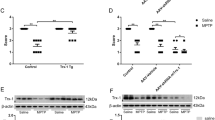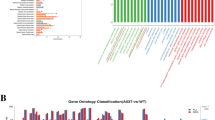Abstract
Parkinson’s disease (PD), a common neurodegenerative disease, is typically associated with the loss of dopaminergic neuron in the substantia nigra pars compacta (SNpc). Ferroptosis is a newly identified cell death, which associated with iron accumulation, glutathione (GSH) depletion, lipid peroxidation formation, reactive oxygen species (ROS) accumulation, and glutathione peroxidase 4 (GPX4) reduction. It has been reported that ferroptosis is linked with PD.Thioredoxin-1 (Trx-1) is a redox regulating protein and plays various roles in regulating the activity of transcription factors and inhibiting apoptosis. However, whether Trx-1 plays the role in regulating ferroptosis involved in PD is still unknown. Our present study showed that 1-methyl-4-phenylpyridinium (MPP+) decreased cell viability, GPX4, and Trx-1, which were reversed by Ferrostatin-1 (Fer-1) in PC 12 cells and SH-SY5Y cells. Moreover, the decreased GPX4 and GSH, and increased ROS were inhibited by Fer-1 and Trx-1 overexpression. We further repeated that behavior deficits resulted from 1-methyl-4-phenyl-1,2,3,6-tetrahydropyridine (MPTP) were improved in Trx-1 overexpression transgenic mice. Trx-1 reversed the decreases of GPX4 and tyrosine hydroxylase (TH) induced by MPTP in the substantia nigra pars compacta (SNpc). Our results suggest that Trx-1 inhibits ferroptosis in PD through regulating GPX4 and GSH.






Similar content being viewed by others

Data Availability
All data is real and guarantees the validity of experimental results.
References
Jiang X, Jin T, Zhang H, Miao J, Zhao X, Su Y, Zhang Y (2019) Current progress of mitochondrial quality control pathways underlying the pathogenesis of Parkinson’s disease. Oxidative Med Cell Longev 2019:4578462–4578411. https://doi.org/10.1155/2019/4578462
Mizuno Y, Suzuki K, Sone N (1990) Inhibition of ATP synthesis by 1-methyl-4-phenylpyridinium ion (MPP+) in mouse brain in vitro and in vivo. Adv Neurol 53:197–200
Przedborski S, Tieu K, Perier C, Vila M (2004) MPTP as a mitochondrial neurotoxic model of Parkinson’s disease. J Bioenerg Biomembr 36(4):375–379. https://doi.org/10.1023/B:JOBB.0000041771.66775.d5
Rostamian Delavar M, Baghi M, Safaeinejad Z, Kiani-Esfahani A, Ghaedi K, Nasr-Esfahani MH (2018) Differential expression of miR-34a, miR-141, and miR-9 in MPP+-treated differentiated PC12 cells as a model of Parkinson’s disease. Gene 662:54–65. https://doi.org/10.1016/j.gene.2018.04.010
Masaldan S, Bush AI, Devos D, Rolland AS, Moreau C (2019) Striking while the iron is hot: iron metabolism and ferroptosis in neurodegeneration. Free Radic Biol Med 133:221–233. https://doi.org/10.1016/j.freeradbiomed.2018.09.033
Angelova PR, Choi ML, Berezhnov AV, Horrocks MH, Hughes CD, De S, Rodrigues M, Yapom R et al (2020) Alpha synuclein aggregation drives ferroptosis: an interplay of iron, calcium and lipid peroxidation. Cell Death Differ 27:2781–2796. https://doi.org/10.1038/s41418-020-0542-z
Deas E, Cremades N, Angelova PR, Ludtmann MH, Yao Z, Chen S, Horrocks MH, Banushi B et al (2016) Alpha-Synuclein oligomers interact with metal ions to induce oxidative stress and neuronal death in Parkinson’s disease. Antioxid Redox Signal 24(7):376–391. https://doi.org/10.1089/ars.2015.6343
Jelinek A, Heyder L, Daude M, Plessner M, Krippner S, Grosse R, Diederich WE, Culmsee C (2018) Mitochondrial rescue prevents glutathione peroxidase-dependent ferroptosis. Free Radic Biol Med 117:45–57. https://doi.org/10.1016/j.freeradbiomed.2018.01.019
Yumnamcha T, Devi TS, Singh LP (2019) Auranofin mediates mitochondrial dysregulation and inflammatory cell death in human retinal pigment epithelial cells: implications of retinal neurodegenerative diseases. Front Neurosci 13:1065. https://doi.org/10.3389/fnins.2019.01065
Cozza G, Rossetto M, Bosello-Travain V, Maiorino M, Roveri A, Toppo S, Zaccarin M, Zennaro L et al (2017) Glutathione peroxidase 4-catalyzed reduction of lipid hydroperoxides in membranes: the polar head of membrane phospholipids binds the enzyme and addresses the fatty acid hydroperoxide group toward the redox center. Free Radic Biol Med 112:1–11. https://doi.org/10.1016/j.freeradbiomed.2017.07.010
Hauser DN, Dukes AA, Mortimer AD, Hastings TG (2013) Dopamine quinone modifies and decreases the abundance of the mitochondrial selenoprotein glutathione peroxidase 4. Free Radic Biol Med 65:419–427. https://doi.org/10.1016/j.freeradbiomed.2013.06.030
Yoritaka A, Hattori N, Uchida K, Tanaka M, Stadtman ER, Mizuno Y (1996) Immunohistochemical detection of 4-hydroxynonenal protein adducts in Parkinson disease. Proc Natl Acad Sci U S A 93(7):2696–2701. https://doi.org/10.1073/pnas.93.7.2696
Mahoney-Sanchez L, Bouchaoui H, Ayton S, Devos D, Duce JA, Devedjian JC (2020) Ferroptosis and its potential role in the physiopathology of Parkinson’s disease. Progress in neurobiology:101890. doi:https://doi.org/10.1016/j.pneurobio.2020.101890
Bai J, Nakamura H, Kwon YW, Hattori I, Yamaguchi Y, Kim YC, Kondo N, Oka S et al (2003) Critical roles of thioredoxin in nerve growth factor-mediated signal transduction and neurite outgrowth in PC12 cells. J Neurosci 23(2):503–509
Bai L, Zhang S, Zhou X, Li Y, Bai J (2019) Brain-derived neurotrophic factor induces thioredoxin-1 expression through TrkB/Akt/CREB pathway in SH-SY5Y cells. Biochimie 160:55–60. https://doi.org/10.1016/j.biochi.2019.02.011
Cai Y, Zhang X, Zhou X, Wu X, Li Y, Yao J, Bai J (2017) Nicotine suppresses the neurotoxicity by MPP(+)/MPTP through activating alpha7nAChR/PI3K/Trx-1 and suppressing ER stress. Neurotoxicology 59:49–55. https://doi.org/10.1016/j.neuro.2017.01.002
Zhang X, Bai L, Zhang S, Zhou X, Li Y, Bai J (2018) Trx-1 ameliorates learning and memory deficits in MPTP-induced Parkinson’s disease model in mice. Free Radic Biol Med 124:380–387. https://doi.org/10.1016/j.freeradbiomed.2018.06.029
Luo FC, Zhou J, Lv T, Qi L, Wang SD, Nakamura H, Yodoi J, Bai J (2012) Induction of endoplasmic reticulum stress and the modulation of thioredoxin-1 in formaldehyde-induced neurotoxicity. Neurotoxicology 33(3):290–298. https://doi.org/10.1016/j.neuro.2012.02.004
Zeng XS, Jia JJ, Kwon Y, Wang SD, Bai J (2014) The role of thioredoxin-1 in suppression of endoplasmic reticulum stress in Parkinson disease. Free Radic Biol Med 67:10–18. https://doi.org/10.1016/j.freeradbiomed.2013.10.013
Talepoor Ardakani M, Rostamian Delavar M, Baghi M, Nasr-Esfahani MH, Kiani-Esfahani A, Ghaedi K (2019) Upregulation of miR-200a and miR-204 in MPP(+) -treated differentiated PC12 cells as a model of Parkinson’s disease. Mol Genet Genomic Med 7(3):e548. https://doi.org/10.1002/mgg3.548
Hayano M, Yang WS, Corn CK, Pagano NC, Stockwell BR (2016) Loss of cysteinyl-tRNA synthetase (CARS) induces the transsulfuration pathway and inhibits ferroptosis induced by cystine deprivation. Cell Death Differ 23(2):270–278. https://doi.org/10.1038/cdd.2015.93
Zaobornyj T, Mazo T, Perez V, Gomez A, Contin M, Tripodi V, D’Annunzio V, Gelpi RJ (2019) Thioredoxin-1 is required for the cardioprotecive effect of sildenafil against ischaemia/reperfusion injury and mitochondrial dysfunction in mice. Free Radic Res 53(9-10):993–1004. https://doi.org/10.1080/10715762.2019.1661404
Nagatsu T, Nagatsu I (2016) Tyrosine hydroxylase (TH), its cofactor tetrahydrobiopterin (BH4), other catecholamine-related enzymes, and their human genes in relation to the drug and gene therapies of Parkinson’s disease (PD): historical overview and future prospects. J Neural Transm 123(11):1255–1278. https://doi.org/10.1007/s00702-016-1596-4
Cassarino DS, Parks JK, Parker WD Jr, Bennett JP Jr (1999) The parkinsonian neurotoxin MPP+ opens the mitochondrial permeability transition pore and releases cytochrome c in isolated mitochondria via an oxidative mechanism. Biochim Biophys Acta 1453(1):49–62. https://doi.org/10.1016/s0925-4439(98)00083-0
Shishido T, Nagano Y, Araki M, Kurashige T, Obayashi H, Nakamura T, Takahashi T, Matsumoto M et al (2019) Synphilin-1 has neuroprotective effects on MPP(+)-induced Parkinson’s disease model cells by inhibiting ROS production and apoptosis. Neurosci Lett 690:145–150. https://doi.org/10.1016/j.neulet.2018.10.020
Kumar H, Lim HW, More SV, Kim BW, Koppula S, Kim IS, Choi DK (2012) The role of free radicals in the aging brain and Parkinson’s disease: convergence and parallelism. Int J Mol Sci 13(8):10478–10504. https://doi.org/10.3390/ijms130810478
Dixon SJ, Lemberg KM, Lamprecht MR, Skouta R, Zaitsev EM, Gleason CE, Patel DN, Bauer AJ et al (2012) Ferroptosis: an iron-dependent form of nonapoptotic cell death. Cell 149(5):1060–1072. https://doi.org/10.1016/j.cell.2012.03.042
Kagan VE, Mao G, Qu F, Angeli JP, Doll S, Croix CS, Dar HH, Liu B et al (2017) Oxidized arachidonic and adrenic PEs navigate cells to ferroptosis. Nat Chem Biol 13(1):81–90. https://doi.org/10.1038/nchembio.2238
Forred BJ, Daugaard DR, Titus BK, Wood RR, Floen MJ, Booze ML, Vitiello PF (2017) Detoxification of mitochondrial oxidants and apoptotic signaling are facilitated by Thioredoxin-2 and Peroxiredoxin-3 during hyperoxic injury. PLoS One 12(1):e0168777. https://doi.org/10.1371/journal.pone.0168777
Dringen R (2000) Metabolism and functions of glutathione in brain. Prog Neurobiol 62(6):649–671. https://doi.org/10.1016/s0301-0082(99)00060-x
Branco V, Coppo L, Sola S, Lu J, Rodrigues CMP, Holmgren A, Carvalho C (2017) Impaired cross-talk between the thioredoxin and glutathione systems is related to ASK-1 mediated apoptosis in neuronal cells exposed to mercury. Redox Biol 13:278–287. https://doi.org/10.1016/j.redox.2017.05.024
Schriever SC, Zimprich A, Pfuhlmann K, Baumann P, Giesert F, Klaus V, Kabra DG, Hafen U et al (2017) Alterations in neuronal control of body weight and anxiety behavior by glutathione peroxidase 4 deficiency. Neuroscience 357:241–254. https://doi.org/10.1016/j.neuroscience.2017.05.050
Bellinger FP, Bellinger MT, Seale LA, Takemoto AS, Raman AV, Miki T, Manning-Bog AB, Berry MJ et al (2011) Glutathione peroxidase 4 is associated with neuromelanin in substantia nigra and dystrophic axons in putamen of Parkinson’s brain. Mol Neurodegener 6(1):8. https://doi.org/10.1186/1750-1326-6-8
Zilka O, Shah R, Li B, Friedmann Angeli JP, Griesser M, Conrad M, Pratt DA (2017) On the Mechanism of cytoprotection by Ferrostatin-1 and Liproxstatin-1 and the role of lipid peroxidation in FERROPTOTIC CELL DEATH. ACS central science 3(3):232–243. https://doi.org/10.1021/acscentsci.7b00028
Booty LM, Gawel JM, Cvetko F, Caldwell ST, Hall AR, Mulvey JF, James AM, Hinchy EC et al (2019) Selective disruption of mitochondrial thiol redox state in cells and in vivo. Cell Chem Biol 26(3):449–461 e448. https://doi.org/10.1016/j.chembiol.2018.12.002
Watanabe T, Sekine S, Naguro I, Sekine Y, Ichijo H (2015) Apoptosis signal-regulating kinase 1 (ASK1)-p38 pathway-dependent cytoplasmic translocation of the orphan nuclear receptor NR4A2 Is required for oxidative stress-induced necrosis. J Biol Chem 290(17):10791–10803. https://doi.org/10.1074/jbc.M114.623280
Du Y, Zhang H, Zhang X, Lu J, Holmgren A (2013) Thioredoxin 1 is inactivated due to oxidation induced by peroxiredoxin under oxidative stress and reactivated by the glutaredoxin system. J Biol Chem 288(45):32241–32247. https://doi.org/10.1074/jbc.M113.495150
Sun Y, He L, Wang T, Hua W, Qin H, Wang J, Wang L, Gu W et al (2020) Activation of p62-Keap1-Nrf2 Pathway Protects 6-Hydroxydopamine-induced ferroptosis in dopaminergic cells. Mol Neurobiol 57:4628–4641. https://doi.org/10.1007/s12035-020-02049-3
Luo M, Shang L, Brooks MD, Jiagge E, Zhu Y, Buschhaus JM, Conley S, Fath MA et al (2018) Targeting breast cancer stem cell state equilibrium through modulation of redox signaling. Cell Metab 28(1):69–86 e66. https://doi.org/10.1016/j.cmet.2018.06.006
Acknowledgements
We thank Zhizhou Shi and Zewen Fang for their technical assistance with quantitative polymerase chain reaction analysis.
Funding
This work was supported by the National Natural Science Foundation of China (Nos. 81660222, U1202227); the Yunling Scholar (No. 1097821401); and the Key Lab for Oxidative Stress Damage and Defense in University of Yunnan Province (2018).
Author information
Authors and Affiliations
Contributions
Liping Bai performed the biochemical analyses, the western blot, and PCR analysis. Jie Bai designed and supervised the study. Liping Bai and Jie Bai analyzed the data and wrote the paper. Fang Yan and Xianwen Zhang performed the behavioral experiments and contributed to part of the acquisition of animal data. Ruhua Deng and Rou Gu assisted with getting mice tissues. All authors have read and approved final version.
Corresponding author
Ethics declarations
Ethics Approval
Our study followed the conventional requirements of experimental operation and was approved by the local Committee on Animal Use and Protection of Yunnan province (No. LA2008305).
Consent to Participate
Not applicable.
Consent for Publication
Not applicable.
Conflict of Interest
The authors declare no competing interests.
Additional information
Publisher’s Note
Springer Nature remains neutral with regard to jurisdictional claims in published maps and institutional affiliations.
Rights and permissions
About this article
Cite this article
Bai, L., Yan, F., Deng, R. et al. Thioredoxin-1 Rescues MPP+/MPTP-Induced Ferroptosis by Increasing Glutathione Peroxidase 4. Mol Neurobiol 58, 3187–3197 (2021). https://doi.org/10.1007/s12035-021-02320-1
Received:
Accepted:
Published:
Issue Date:
DOI: https://doi.org/10.1007/s12035-021-02320-1



